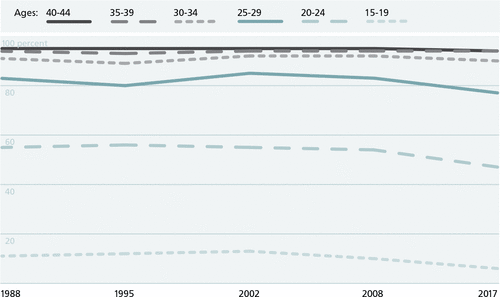Does Cohabitation Compensate for Marriage Decline?

According to Lamidi and Manning, a larger share of young adults have spent time in cohabiting relationships than in marriages over the past decade. Marriage rates have been declining in the U.S. since at least the 1980s, while Bumpass, Sweet, and Cherlin have documented that cohabitation has increased. The rise in cohabitation coupled with the decline in marriage during young adulthood means young adults are still forming coresidential relationships. As a result, Manning, Brown, and Payne have found that cohabitation has compensated for changes in the levels and timing of marriage. According to Andersson, Thomson, and Duntava, the U.S. stands out among other nations for its higher rates of marriage. Young adults in Western European countries almost universally cohabit, and first marriages don’t occur until young adults reach their thirties.
The recent trends might mean that U.S. cohabitation trends may catch up to those of Western Europe. The National Survey of Family Growth (NSFG) is conducted under the auspices of the National Center for Health Statistics and offers current and reliable national statistics to measure changes to marriage and cohabitation. The NSFG study design includes repeated interviews with adults of child-bearing age who are asked direct questions about their cohabitation experiences, making the NSFG one of the only data sources to capture change over time in cohabitation. Prior to 2002, the data collection covered single year periods but since then it has shifted to continuous interviewing representing multiple years. Focusing on the 1988 through 2010 time period Manning and colleagues found that cohabitation was rising, and marriage was declining, resulting in similar shares of women forming unions across age groups.
We analyzed new data from nearly 9,000 Black, White, and Hispanic women who were between the ages of 15 to 44 during the period from 2015-2019. Women answered whether they had ever cohabited or married. Because of the way the questions were asked, the responses were, unfortunately, limited to “opposite sex” cohabitation and marriage. We ended up only being able to analyze trends for women married to or cohabiting with men. Given the short duration of cohabiting unions, which last about two years on average, it is important to measure whether women were ever part of a union rather than whether they were currently in one.
Since 2010 cohabitation rates have stagnated while marriage levels continue to plummet. In contrast to the trend through 2010, during which cohabitation seemed to replace marriage, recently fewer women formed any type of unions. Two age groups can help show what changed, women aged 25-29 and 40-44. These two groups represent young adults who were in the early family building stages and midlife adults who had largely completed family building. The share of women who had ever married has continued to decline. The trend was strongest among young adults and reflected delays in marriage (Figure 1). Among women aged 25-29, 55 percent had ever married a decade ago, but only 41 percent of this age group in the 2015-2019 time period had ever married. Among women aged 40-44, the share ever married declined from 88 percent to 81 percent.

In contrast, cohabitation rates did not change much in the 2010s, after they grew steadily from 1988 and 2010 so the growth in cohabitation appears to be stalling. Figure 2 shows 63 percent of women aged 25-29 in the 2006 and 2010 period had ever cohabited, while 65 percent had ever cohabited more recently (2015-2019). Similarly, among women aged 40-44, the share which cohabited remained stable at 72 percent over the last decade.

The result has been that fewer women have formed unions. Figure 3 shows, for the period from 1988-2010, about 83 percent of women aged 25-29 had ever cohabited or married. The share who cohabited or married dipped to 77 percent in the recent period (2015-2019). Among women aged 40-44 almost all (about 94 percent) had formed a union with no change over time from 19882010 because increases in cohabitation fully countered the decline in marriage across age groups. Since then, stagnation in cohabitation will mean cohabitation is not compensating for the sustained decline in marriage among young adults.

Our analysis shows that, among young adults, cohabitation no longer offsets the decline in marriage because cohabitation has plateaued. This cohabitation stall portends a shift to lower levels of overall union formation during young adulthood and may presage declining levels of marriage and cohabitation into middle age. Further, our findings call into question the widely accepted notion that the U.S. is on a path to reach the nearly universal levels of cohabitation observed in Western Europe. In the U.S., if current trends among young adults continue across age groups, cohabitation will no longer supplant marriage. Women will be less likely to form any union instead.

Comments 1
Malti Joshi
July 2, 2021Since then, stagnation in cohabitation will mean cohabitation is not compensating for the sustained decline in marriage among young adults.